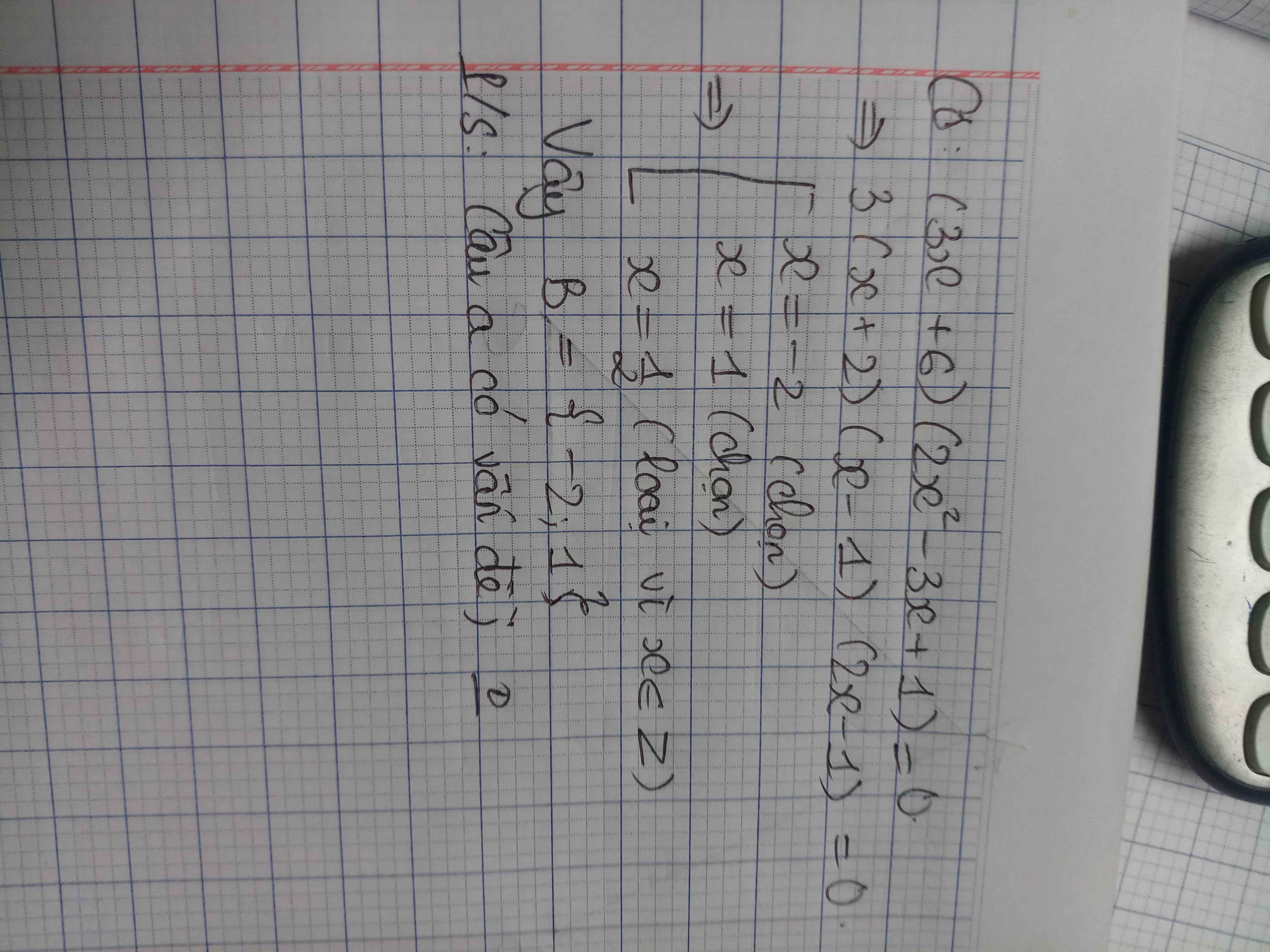hãy liệt kê các phần tử của tập hợp B = { x ∈ R | 5x² + 3x + 1 = 0}

Những câu hỏi liên quan
Tập hợp B các nghiệm của phương trình 2x2 – 5x + 3 = 0 được viết là B = { x ∈ R | 2x2 – 5x + 3 = 0}
Hãy liệt kê các phần tử của tập hợp B.
Hãy liệt kê các phần tử của tập hợp: A = { x ∈ R | x2 + x + 1 = 0}
Do phương trình x2 + x + 1 = 0 vô nghiệm nên tập hợp A không có phần tử nào
Đúng 0
Bình luận (0)
Hãy liệt kê các phần tử của tập hợp sau :
A = { 3n² - 2n +1 | n ≤ 3 , n ∈ N* }
B = { x ∈ Z | ( 3x + 6 ) ( 2x² - 3x + 1 ) = 0 }
\(A=\left\{2;9;22\right\}\)
\(B=\left\{-2;1\right\}\)
Đúng 1
Bình luận (0)
\(B=\left\{-2;1;\dfrac{1}{2}\right\}\)
Đúng 0
Bình luận (0)
Hãy liệt kê các phần tử của tập
X
x
∈
ℝ
2
x
2
−
5
x
+
3
0
A.
X
0
B.
X
1
C.
X...
Đọc tiếp
Hãy liệt kê các phần tử của tập X = x ∈ ℝ 2 x 2 − 5 x + 3 = 0
A. X = 0
B. X = 1
C. X = 3 2
D. X = 1 ; 3 2
Đáp án D
Ta có: 2 x 2 − 5 x + 3 = 0 ⇔ x = 1 ∈ ℝ x = 3 2 ∈ ℝ
nên X = 1 ; 3 2
Đúng 0
Bình luận (0)
Viết mỗi tập hợp sau bằng cách liệt kê các phần tử
a) A= {x ∈ R | (2x – x2)( 3x – 2) = 0}
b, B = { x∈ Z | 2x3-3x2-5x = 0 }
c , C= { x ∈ Z | 2x2 -75x -77 = 0 }
d , D = { x ∈ R | (x2 - x - 2 ) (x2 - 9 ) = 0 } .
`#3107.101107`
a,
\(\text{A = }\left\{x\in R\text{ | }\left(2x-x^2\right)\left(3x-2\right)=0\right\}\)
`<=> (2x - x^2)(3x - 2) = 0`
`<=>`\(\left[{}\begin{matrix}2x-x^2=0\\3x-2=0\end{matrix}\right.\)
`<=>`\(\left[{}\begin{matrix}x\left(2-x\right)=0\\3x=2\end{matrix}\right.\)
`<=>`\(\left[{}\begin{matrix}x=0\\2-x=0\\x=\dfrac{2}{3}\end{matrix}\right.\)
`<=>`\(\left[{}\begin{matrix}x=0\\x=2\\x=\dfrac{2}{3}\end{matrix}\right.\)
Vậy, `A = {0; 2; 2/3}`
b,
\(\text{B = }\left\{x\in R\text{ | }2x^3-3x^2-5x=0\right\}\)
`<=> 2x^3 - 3x^2 - 5x = 0`
`<=> x(2x^2 - 3x - 5) = 0`
`<=>`\(\left[{}\begin{matrix}x=0\\2x^2-3x-5=0\end{matrix}\right.\)
`<=>`\(\left[{}\begin{matrix}x=0\\2x^2-2x+5x-5=0\end{matrix}\right.\)
`<=>`\(\left[{}\begin{matrix}x=0\\\left(2x^2-2x\right)+\left(5x-5\right)=0\end{matrix}\right.\)
`<=>`\(\left[{}\begin{matrix}x=0\\2x\left(x-1\right)+5\left(x-1\right)=0\end{matrix}\right.\)
`<=>`\(\left[{}\begin{matrix}x=0\\\left(2x+5\right)\left(x-1\right)=0\end{matrix}\right.\)
`<=>`\(\left[{}\begin{matrix}x=0\\2x+5=0\\x-1=0\end{matrix}\right.\)
`<=>`\(\left[{}\begin{matrix}x=0\\x=-\dfrac{5}{2}\\x=1\end{matrix}\right.\)
Vậy, `B = {-5/2; 0; 1}.`
Đúng 3
Bình luận (0)
c,
\(\text{C = }\left\{x\in Z\text{ | }2x^2-75x-77=0\right\}\)
`<=> 2x^2 - 75x - 77 = 0`
`<=> 2x^2 - 2x + 77x - 77 = 0`
`<=> (2x^2 - 2x) + (77x - 77) = 0`
`<=> 2x(x - 1) + 77(x - 1) = 0`
`<=> (2x + 77)(x - 1) = 0`
`<=>`\(\left[{}\begin{matrix}2x+77=0\\x-1=0\end{matrix}\right.\)
`<=>`\(\left[{}\begin{matrix}2x=-77\\x=1\end{matrix}\right.\)
`<=>`\(\left[{}\begin{matrix}x=-\dfrac{77}{2}\\x=1\end{matrix}\right.\)
Vậy, `C = {-77/2; 1}`
d,
\(\text{D = }\left\{x\in R\text{ | }\left(x^2-x-2\right)\left(x^2-9\right)=0\right\}\)
`<=> (x^2 - x - 2)(x^2 - 9) = 0`
`<=>`\(\left[{}\begin{matrix}x^2-x-2=0\\x^2-9=0\end{matrix}\right.\)
`<=>`\(\left[{}\begin{matrix}x^2+x-2x-2=0\\x^2=9\end{matrix}\right.\)
`<=>`\(\left[{}\begin{matrix}\left(x^2+x\right)-\left(2x+2\right)=0\\x^2=\left(\pm3\right)^2\end{matrix}\right.\)
`<=>`\(\left[{}\begin{matrix}x\left(x+1\right)-2\left(x+1\right)=0\\x=\pm3\end{matrix}\right.\)
`<=>`\(\left[{}\begin{matrix}\left(x-2\right)\left(x+1\right)=0\\x=\pm3\end{matrix}\right.\)
`<=>`\(\left[{}\begin{matrix}x-2=0\\x+1=0\\x=\pm3\end{matrix}\right.\)
`<=>`\(\left[{}\begin{matrix}x=2\\x=-1\\x=\pm3\end{matrix}\right.\)
Vậy, `D = {-1; -3; 2; 3}.`
Đúng 2
Bình luận (0)
cho tập hợp B = {x thuộc n / 3x + 1 =10 } viết tập hợp b bằng cách liệt kê các phần tử của tập hợp
3x + 1 = 10
3x = 10 - 1
3x = 9
x = 9 : 3
x = 3
Vậy B = {3}
Đúng 1
Bình luận (0)
3x + 1 = 10
3x = 10 - 1
3x = 9
x = 9 : 3
x = 3
Vậy B = {3}
Đúng 0
Bình luận (0)
Xem thêm câu trả lời
Cho \(A = \left\{ {x \in \mathbb{Z}|\;x < 4} \right\},\) \( \,B = \left\{ {x \in \mathbb{Z}|\;\left( {5x - 3{x^2}} \right)\left( {{x^2} + 2x - 3} \right) = 0} \right\}\)
a) Liệt kê các phần tử của hai tập hợp A và B.
b) Hãy xác định các tập hợp \(A \cap B,A \cup B\) và \(A\,{\rm{\backslash }}\,B\)
a) \(A = \{ 3;2;1;0; - 1; - 2; - 3; -4; ...\} \)
Tập hợp B là tập các nghiệm nguyên của phương trình \(\left( {5x - 3{x^2}} \right)\left( {{x^2} + 2x - 3} \right) = 0\)
Ta có:
\(\begin{array}{l}\left( {5x - 3{x^2}} \right)\left( {{x^2} + 2x - 3} \right) = 0\\ \Leftrightarrow \left[ \begin{array}{l}5x - 3{x^2} = 0\\{x^2} + 2x - 3 = 0\end{array} \right.\\ \Leftrightarrow \left[ \begin{array}{l}\left[ \begin{array}{l}x = 0\\x = \frac{5}{3}\end{array} \right.\\\left[ \begin{array}{l}x = 1\\x = - 3\end{array} \right.\end{array} \right.\end{array}\)
Vì \(\frac{5}{3} \notin \mathbb Z\) nên \(B = \left\{ { - 3;0;1} \right\}\).
b) \(A \cap B = \left\{ {x \in A|x \in B} \right\} = \{ - 3;0;1\} = B\)
\(A \cup B = \) {\(x \in A\) hoặc \(x \in B\)} \( = \{ 3;2;1;0; - 1; - 2; - 3;...\} = A\)
\(A\,{\rm{\backslash }}\,B = \left\{ {x \in A|x \notin B} \right\} = \{ 3;2;1;0; - 1; - 2; - 3;...\} {\rm{\backslash }}\;\{ - 3;0;1\} = \{ 3;2; - 1; - 2; - 4; - 5; - 6;...\} \)
Đúng 0
Bình luận (0)
a) C={ n thuộc N / n là bội của 5 và n <= 30
b) D= { x thuộc R / x mũ 2 +3x-4 = 0}
viết tập hợp sau bằng cách liệt kê các phần tử
\(a,C=\left\{0;5;10;15;20;25;30\right\}\\ b,x^2+3x-4=0\\ \Leftrightarrow x^2-x+4x-4=0\\ \Leftrightarrow x\left(x-1\right)+4\left(x-1\right)=0\\ \Leftrightarrow\left(x-1\right)\left(x+4\right)=0\\ \Leftrightarrow x-1=0.hoặc.x+4=0\\ \Leftrightarrow x=1.hoặc.x=-4\\ Vậy:D=\left\{-4;1\right\}\)
Đúng 2
Bình luận (0)
Viết mỗi tập hợp sau bằng cách liệt kê các phần tử:
a) A = { \(x\in Z\) | \(2x^3-3x^2-5x=0\) }
b) B = { \(x\in Z\) | \(x< \left|3\right|\) }
c) C = { x = 3k; x, \(k\in Z\); -4<x<12 }
a) \(2x^3-3x^2-5x=0\)
\(x\left(x+1\right)\left(2x-5\right)=0\)
\(\Rightarrow\left[{}\begin{matrix}x=0\left(L\right)\\x=-1\left(TM\right)\\x=\dfrac{5}{2}\left(L\right)\end{matrix}\right.\)
\(A=\left\{-1\right\}\)
b) \(x< \left|3\right|\)\(\Leftrightarrow-3< x< 3\)
\(B=\left\{-2;-1;1;2\right\}\)
c) \(C=\left\{-3;3;6;9\right\}\)
Đúng 1
Bình luận (0)
a) \(A=\left\{x\in Z|2x^3-3x^2-5x=0\right\}\)
\(2x^3-3x^2-5x=0\)
\(\Leftrightarrow x\left(2x^2-3x-5\right)=0\)
\(\Leftrightarrow x\left(x+1\right)\left(2x-5\right)=0\)
\(\Leftrightarrow\left[{}\begin{matrix}x=0\\x=-1\\x=\dfrac{5}{2}\left(loại\right)\end{matrix}\right.\)
\(\Rightarrow A=\left\{0;-1\right\}\)
b) \(B=\left\{-2;-1;0;1;2\right\}\)
c) \(C=\left\{-3;3;6;9\right\}\)
Đúng 0
Bình luận (0)


























